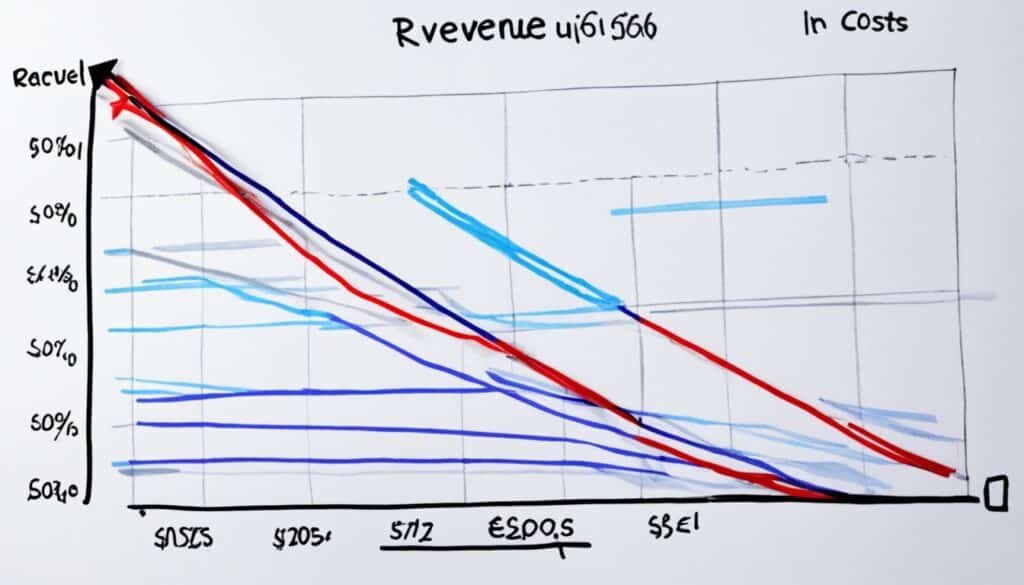Understanding and implementing key principles of business finance is crucial for unlocking the secrets of success in any venture. Whether you are a non-finance professional seeking to enhance your skills or an entrepreneur looking to drive your business forward, having a solid foundation in business finance is essential. By mastering financial management, planning, and skills, you can make informed decisions, allocate resources efficiently, manage risk, and communicate effectively.
Key Takeaways:
- Financial management skills are vital for successful decision-making and resource allocation.
- Financial literacy enhances leadership abilities and fosters effective communication.
- Finance skills benefit professionals in various roles, including non-finance managers, entrepreneurs, small business owners, and those in transition.
- Understanding financial statements and analysis is crucial for effective financial management.
- An annual report provides valuable insights into a company’s financial performance and strategic alignment.
The Importance of Financial Literacy
Financial literacy is essential for professionals and entrepreneurs who aim to make informed decisions, allocate resources efficiently, manage risks, and communicate effectively. With a solid understanding of financial concepts and practices, individuals can navigate the complexities of financial decision-making and drive their organizations towards success.
One of the key benefits of financial literacy is its impact on decision-making. By having a clear understanding of the financial implications of choices, professionals can make well-informed decisions that align with their goals. Whether it’s evaluating investment opportunities, choosing between different funding options, or determining the best pricing strategy, financial literacy provides the knowledge and confidence to make sound choices.
Moreover, financial literacy enables efficient resource allocation. By understanding the financial health of their businesses, professionals can allocate budgets and resources effectively. This ensures that limited resources are utilized optimally, maximizes return on investment, and minimizes wastage.
In addition to decision-making and resource allocation, financial literacy plays a crucial role in risk management. Professionals equipped with financial acumen can identify potential risks and develop strategies to mitigate them. By analyzing financial data, assessing market trends, and understanding the impact of external factors, individuals can navigate uncertainty and protect the financial stability of their organizations.
Effective communication of financial information is another vital aspect of financial literacy. Professionals need to effectively communicate financial results, forecasts, and strategies to stakeholders, investors, and team members. Clear and concise communication builds trust, fosters collaboration, and enhances leadership abilities.
Financial literacy empowers professionals and entrepreneurs to make informed decisions, allocate resources wisely, manage risks proactively, and communicate effectively. With a solid foundation in financial literacy, individuals can navigate the challenges of the business world and drive their organizations towards long-term success.
The integration of financial literacy into professional development programs and educational curricula is crucial to equip individuals with the necessary skills and knowledge. By investing in financial literacy, organizations can enhance the capabilities of their workforce and pave the way for sustainable growth.
By prioritizing financial literacy, professionals and entrepreneurs can unlock the potential for financial success and ensure their organizations thrive in a dynamic and competitive business environment.
| Benefits of Financial Literacy |
|---|
| Enhanced Decision-Making: Clear understanding of financial implications |
| Efficient Resource Allocation: Optimal use of budgets and resources |
| Risk Management: Identification and mitigation of risks |
| Effective Communication: Clear and concise financial information |
Target Audiences for Finance Skills
The “Finance Skills for Non-Finance Managers” program is designed to benefit a wide range of professionals. Whether you are a non-finance manager, an entrepreneur, a small business owner, or a professional in transition, acquiring financial knowledge and skills can greatly enhance your career prospects and contribute to your success in the business world.
Non-Finance Managers
Non-finance managers play a crucial role in organizations by overseeing operations, making strategic decisions, and optimizing resources. By gaining financial knowledge and skills, non-finance managers can confidently contribute to strategic planning, effectively allocate resources, and build a strong financial foundation for their teams. This not only enhances their own career growth but also promotes the overall success of the organization.
Entrepreneurs and Small Business Owners
For entrepreneurs and small business owners, financial skills are essential for the success and sustainability of their ventures. Understanding financial management helps in managing cash flow, securing funding, and developing realistic business plans. By acquiring financial expertise, entrepreneurs and small business owners can make informed financial decisions, seize growth opportunities, and navigate the challenges of running a business.
Professionals in Transition
Professionals in transition, whether through career changes or job advancements, can greatly benefit from acquiring versatile and marketable financial skills. The ability to understand and analyze financial information makes professionals more attractive candidates for managerial positions across various industries. Financial skills provide a competitive edge and open doors to new career opportunities.

Financial Management Fundamentals
Understanding financial principles is essential for effective financial management. By analyzing financial statements, interpreting financial data, and conducting financial analysis, professionals can make strategic decisions based on accurate information.
Financial principles serve as the foundation for sound financial management practices. By comprehending these principles, professionals gain a deeper understanding of their organization’s financial health, identify areas for improvement, and make informed decisions regarding resource allocation.
The Importance of Financial Statements
Financial statements are crucial tools for assessing an organization’s financial performance. They provide a snapshot of its financial position, including assets, liabilities, and equity. The three main financial statements are:
- Balance Sheet: Displays the company’s assets, liabilities, and shareholders’ equity at a specific point in time.
- Income Statement: Summarizes the company’s revenues, expenses, and net income over a specific period.
- Cash Flow Statement: Details the company’s cash inflows and outflows during a specific period.
By analyzing these financial statements, professionals can gain insights into the company’s financial strengths, weaknesses, and overall financial health. This information helps guide decision-making processes, such as budgeting, forecasting, and investment evaluation.
Conducting Financial Analysis
Financial analysis involves examining financial data to assess an organization’s performance, profitability, and efficiency. It provides valuable insights into the company’s financial health and sustainability. Key financial analysis techniques include:
- Ratio Analysis: Evaluates the relationship between various financial variables to assess performance and identify trends.
- Trend Analysis: Compares financial data over multiple periods to identify patterns and trends in performance.
- Profitability Analysis: Measures the company’s ability to generate profit by analyzing factors such as gross margin, operating margin, and net margin.
- Liquidity Analysis: Assesses the company’s ability to meet short-term obligations by examining its current and quick ratios.
Through financial analysis, professionals can identify areas of strength and weakness within their organization and make necessary adjustments to improve financial performance.
Developing a comprehensive understanding of financial principles, financial statements, and financial analysis techniques is crucial for professionals in finance roles. It empowers them to contribute to the organization’s financial success and make informed decisions for sustainable growth.

Understanding the Annual Report
The annual report serves as a critical document that offers valuable insights into a company’s financial performance and strategic alignment. It provides essential information for professionals to evaluate a company’s financial health and make informed decisions. By understanding the components of an annual report and how they relate to the overall business strategy, professionals can gain a comprehensive understanding of a company’s position in the market.
The annual report not only presents financial statements but also provides a detailed analysis of a company’s performance, goals, and future prospects. It offers a holistic view of the organization’s operations, highlighting key achievements, challenges, and risks. By examining the annual report, professionals can assess whether a company’s objectives and strategies align with its financial performance.
Evaluating Financial Performance
One crucial aspect of the annual report is the financial statements, which offer a comprehensive overview of a company’s financial performance. These statements include the income statement, balance sheet, and cash flow statement. The income statement reflects the company’s revenue, expenses, and profitability, while the balance sheet provides an overview of the company’s assets, liabilities, and equity. The cash flow statement outlines the company’s cash inflows and outflows, offering insights into liquidity and solvency.
Professionals need to analyze these financial statements to assess the company’s financial health, profitability, and sustainability. Key financial ratios and performance indicators such as return on investment (ROI), earnings per share (EPS), and debt-to-equity ratio provide further insights into the company’s financial position.
Strategic Alignment
Besides financial performance, the annual report also showcases a company’s strategic alignment. It includes information on the company’s mission, vision, values, and strategic initiatives. The management discussion and analysis (MD&A) section provides in-depth insights into the company’s strategic direction, major projects, and risks. This section helps professionals understand how the company’s financial decisions align with its long-term goals and overall business strategy.
By comprehending the strategic alignment of a company, professionals can evaluate its potential for growth and sustainability. They can assess whether the company’s strategies are effective in adapting to market changes, mitigating risks, and capitalizing on opportunities.
Understanding the annual report enables professionals and investors to make better-informed decisions. It offers an in-depth perspective on the financial performance and strategic direction of a company. By analyzing financial statements and assessing the company’s strategic alignment, professionals can evaluate the company’s financial health and suitability for investment.

Financial Budgets and Plans
Developing financial budgets and plans is crucial for effective financial management. Strategic planning involves setting long-term goals and aligning financial resources to achieve them. Budget planning ensures that resources are allocated wisely, and forecasting helps in predicting future income and expenses. These practices enable organizations to plan for the future and maintain control over cash flow.
Strategic planning is the process of defining the long-term objectives of an organization and developing strategies to achieve them. It involves analyzing market trends, identifying opportunities, and making decisions that align with the organization’s goals. By aligning financial resources with strategic plans, businesses can allocate budgets more effectively, ensuring that financial resources are invested in areas that contribute to overall success.
Budget planning plays a crucial role in financial management by defining the financial requirements for a specific period. It includes estimating future expenses, projecting revenue, and determining the allocation of resources. By establishing a budget, businesses can make informed decisions about resource allocation and prioritize investments. This ensures that every dollar is spent wisely and contributes to the organization’s overall objectives.
Forecasting is the process of using historical data and market trends to predict future financial outcomes. It involves analyzing past performance, identifying patterns, and making projections about income and expenses. By forecasting future cash flows, businesses can anticipate potential challenges, identify opportunities for growth, and make strategic decisions to optimize financial resources.
Here is an example of how strategic planning, budget planning, and forecasting work together:
| Activity | Description |
|---|---|
| Strategic Planning | Identify long-term goals and objectives |
| Develop strategies to achieve goals | |
| Align financial resources with strategies | |
| Budget Planning | Estimate future expenses and revenue |
| Determine resource allocation | |
| Set spending limits | |
| Forecasting | Analyze historical data and market trends |
| Predict future income and expenses | |
| Identify potential challenges and opportunities |
By integrating these practices, organizations can develop comprehensive financial budgets and plans that support their strategic goals, ensure efficient use of resources, and enable them to navigate the uncertainties of the business environment.

Evaluating Project Feasibility
When considering potential investments, it is crucial to evaluate the feasibility of projects. This assessment allows managers to determine the financial viability and profitability of an investment opportunity. Understanding the concepts of contribution and break-even analysis plays a vital role in making informed investment decisions and maximizing return on investment.
Contribution refers to the revenue generated from a project that contributes towards covering the project’s fixed and variable costs. It helps managers understand the financial impact of a project and determine its profitability. By analyzing the contribution margin, which is the difference between revenue and variable costs, managers can assess the project’s potential for generating profits.
Break-even analysis is another critical concept in evaluating project feasibility. It allows managers to determine the point at which a project’s total revenue equals its total costs, resulting in neither profit nor loss. This break-even point is calculated by dividing the fixed costs by the contribution margin. Understanding the break-even point helps managers assess the minimum amount of revenue required to cover costs and make the project financially viable.
“Evaluating project feasibility requires a deep understanding of contribution and break-even analysis. These concepts provide crucial insights into the financial viability and profitability of potential investments.” – John Smith, Finance Manager
By applying contribution and break-even analysis, managers can make informed decisions about allocating resources effectively and maximizing the return on investment. This evaluation process helps mitigate financial risks and ensures that projects align with the organization’s financial objectives.

| Concept | Description |
|---|---|
| Contribution | The revenue generated from a project that contributes towards covering the project’s fixed and variable costs. |
| Break-even analysis | An analysis that identifies the point at which a project’s total revenue equals its total costs, resulting in neither profit nor loss. |
Bookkeeping and Accounting
Bookkeeping and accounting play a crucial role in financial management. Bookkeeping involves meticulously recording and organizing financial transactions, ensuring accuracy and completeness in the company’s financial records. On the other hand, accounting involves analyzing and interpreting financial data, providing valuable insights into the financial health of the organization.
Accurate bookkeeping serves as the foundation for reliable financial statements, which are essential for making informed business decisions. By maintaining precise records of income, expenses, assets, and liabilities, businesses can gain a comprehensive understanding of their financial standings and long-term goals.
Here is an example of how bookkeeping and accounting can help businesses:
| Benefits of Bookkeeping and Accounting |
|---|
| 1. Facilitates financial analysis and decision-making |
| 2. Provides a clear picture of the business’s financial position |
| 3. Enables compliance with tax regulations |
| 4. Assists in budgeting and financial planning |
| 5. Supports effective cash flow management |
By utilizing bookkeeping and accounting practices, businesses can optimize their financial management, improve their strategic decision-making, identify areas for growth and improvement, and ensure compliance with regulatory requirements.
“Accurate and meticulous bookkeeping is the cornerstone of effective financial management. It provides businesses with a solid foundation for analyzing their financial position and making informed decisions.”
Having a dedicated bookkeeping system and utilizing accounting principles enables businesses to maintain control over their financial transactions and improve their overall financial performance. By understanding the importance of bookkeeping and accounting, businesses can establish a strong financial management framework that drives success.

Bookkeeping and accounting enable businesses to navigate the complexities of financial transactions, identify opportunities for growth, and ensure the accuracy and integrity of their financial data. By prioritizing these critical functions, businesses can achieve their financial goals and set a solid foundation for sustainable success.
The Role of Budgeting
Effective budgeting plays a vital role in financial management, offering businesses the necessary tools to maintain control over cash flow and allocate resources efficiently. By carefully planning and tracking expenses, businesses can achieve financial stability and make informed decisions based on their financial capabilities.
Setting Spending Limits
One of the primary functions of budgeting is to set spending limits for various activities and departments within a business. By establishing clear boundaries and allocating funds appropriately, companies can prevent overspending and ensure that resources are used effectively.
Expense Tracking and Control
Tracking expenses is a critical component of budgeting. By accurately recording and categorizing expenses, businesses gain visibility into their spending patterns and identify areas where cost reductions can be made. This level of control enables them to respond quickly to changing financial circumstances and make data-driven decisions to optimize their financial performance.
Planning for Future Expenses
Budgeting helps businesses anticipate and plan for future expenses. By forecasting income and estimating costs, companies can prepare for upcoming financial obligations and allocate resources accordingly. This proactive approach allows businesses to avoid cash flow shortages and potential debt, ensuring long-term stability and sustainability.
“Budgeting helps businesses anticipate and plan for future expenses, ensuring long-term stability and sustainability.”
Strategic Decision Making
When businesses have a well-planned budget in place, they can make strategic decisions with confidence. Budgeting provides a framework for evaluating opportunities and risks, allowing companies to allocate resources to initiatives that align with their goals and priorities.
| Budgeting Benefits | Description |
|---|---|
| Financial Discipline | Helps businesses instill discipline in managing their finances, promoting responsible spending and resource allocation. |
| Goal Alignment | Enables businesses to align their financial goals with their overall strategic objectives, ensuring that resources are directed where they are most needed. |
| Risk Mitigation | By planning for potential financial challenges, businesses can minimize risk and safeguard their financial viability. |
| Performance Evaluation | Budgeting provides a benchmark for measuring performance, helping businesses identify areas of improvement and take corrective actions. |

Budgeting is an essential tool for cash flow management, expense tracking, and ensuring financial stability. By committing resources intelligently, businesses can navigate economic uncertainties confidently and position themselves for long-term growth and success.
The Importance of Forecasting
Forecasting is a crucial component of financial management that allows businesses to make informed decisions based on historical data and current trends. By analyzing past performance and predicting future outcomes, organizations can anticipate income and expenses, enabling them to plan effectively and stay ahead of the competition.
Accurate forecasting provides valuable insights for businesses in various areas, including:
- Investment decisions: By examining historical data and market trends, businesses can evaluate the potential returns and risks associated with investment opportunities. This informed approach to decision-making helps companies allocate resources wisely.
- Financial planning: Forecasting allows businesses to anticipate future income and expenses, enabling the creation of comprehensive financial plans. This proactive approach helps organizations manage cash flow, effectively budget resources, and set realistic financial goals.
- Expansion strategies: By forecasting future demand and market conditions, businesses can determine the optimal timing and approach for expanding their operations. This helps organizations allocate resources efficiently and identify potential growth opportunities.
By leveraging historical data and incorporating accurate forecasting techniques, businesses can make well-informed decisions that drive success. With the ability to anticipate market trends, revenue streams, and potential expenses, organizations can strategically position themselves for sustainable growth and profitability.

The Benefits of Accurate Forecasting
Accurate forecasting offers numerous benefits for businesses, including:
- Informed decision-making: By relying on historical data and market insights, businesses can make decisions based on reliable information rather than assumptions. This increases the likelihood of successful outcomes and minimizes the risk of costly mistakes.
- Resource optimization: Forecasting helps businesses allocate resources efficiently by aligning them with anticipated demand and revenue. This ensures optimal utilization of budgets and prevents unnecessary expenses.
- Proactive risk management: By identifying potential challenges and market fluctuations in advance, businesses can develop contingency plans and minimize potential risks. This proactive approach to risk management helps organizations maintain stability and navigate uncertain economic conditions.
Accurate forecasting empowers businesses to make data-driven decisions, adapt to changing market dynamics, and pursue sustainable growth. By harnessing the power of historical data and informed predictions, organizations can stay ahead of the curve and achieve their financial goals.
“Accurate forecasting allows businesses to navigate the complexities of the market and make informed decisions that drive sustainable growth.” – Financial Expert
| Benefits of Accurate Forecasting | Key Advantages |
|---|---|
| Informed decision-making | Increases success rate, minimizes risks |
| Resource optimization | Efficient allocation, cost reduction |
| Proactive risk management | Anticipates challenges, ensures stability |
Finance Management for Business Success
Effective financial management is essential for business success. By implementing sound financial practices, businesses can minimize risk, maximize profits, enhance decision-making capabilities, and drive long-term sustainable growth. With a strong foundation in financial management, businesses can maintain financial stability, achieve their goals, and adapt to changing economic conditions.
The Benefits of Financial Management
Financial management plays a crucial role in every aspect of a business. It involves planning, organizing, controlling, and monitoring financial resources to achieve organizational objectives. By effectively managing finances, businesses can:
- Mitigate Risk: Financial management helps identify and mitigate potential risks, ensuring the stability and security of the business.
- Maximize Profits: With proper financial management, businesses can optimize revenue streams, control costs, and maximize profitability.
- Enhance Decision-Making: Financial data and analysis enable informed decision-making, supporting strategies that drive growth and success.
- Drive Sustainable Growth: By maintaining a balanced approach to financial management, businesses can achieve long-term sustainability and growth.
Financial management encompasses various aspects, including:
“Financial management incorporates financial planning, budgeting, forecasting, cash flow management, investment analysis, risk assessment, and financial reporting. These tools and practices provide businesses with insights and strategies for achieving financial success.”
Implementing Effective Financial Practices
To achieve financial success, businesses must implement effective financial management practices:
- Establish Clear Financial Goals: Set measurable targets and create a roadmap for financial success.
- Develop Robust Financial Systems: Implement reliable systems for bookkeeping, accounting, and financial reporting.
- Monitor and Track Financial Performance: Regularly review financial statements and key performance indicators to assess progress and make necessary adjustments.
- Manage Cash Flow: Maintain control over cash inflows and outflows to ensure a healthy cash flow cycle.
- Invest Wisely: Conduct thorough investment analysis and risk assessments to make informed investment decisions.
- Adapt to Changing Economic Conditions: Stay updated on market trends and adjust financial strategies accordingly.
Sustainable Growth Through Financial Management
Financial management is the backbone of sustainable business growth. It enables businesses to make prudent financial decisions, plan for the future, and adapt to market fluctuations. By prioritizing financial management, businesses can navigate challenges, seize opportunities, and achieve long-term success.
Also Read : Exploring Trends in the Business Industry

| Benefits of Financial Management | Key Practices for Financial Success |
|---|---|
|
|
Conclusion
Business finance is the cornerstone of achieving success in any venture. By understanding key financial principles, developing essential skills, and implementing sound financial management practices, professionals and entrepreneurs can effectively navigate the complexities of financial decision-making, secure funding, and drive their businesses towards sustainable growth.
Financial success is within reach for those who prioritize financial literacy and make informed financial decisions. By acquiring a solid foundation in business finance, individuals can gain the knowledge and skills necessary to analyze financial statements, interpret data, and conduct financial analysis. These capabilities enable them to make strategic decisions based on accurate information, effectively allocate resources, and manage risks.
Furthermore, the ability to communicate financial information is paramount for building trust and enhancing leadership abilities. By effectively communicating financial data and insights, professionals can gain the confidence and support of stakeholders, promoting collaboration and informed decision-making.
FAQ
Q: What is business finance?
A: Business finance involves managing the financial aspects of a company, including equity, profit, debt financing, and short-term financial planning.
Q: Why is financial planning important for businesses?
A: Financial planning is crucial for businesses to ensure they have enough capital to operate, invest in new product lines, and manage cash flow effectively.
Q: How can a company benefit from debt financing?
A: Debt financing can provide a company with the necessary funds to expand operations, launch new projects, or invest in capital assets without giving up ownership.
Q: What are the key responsibilities of a finance department?
A: The finance department is responsible for managing the company’s financial operations, financial planning, raising capital, and overseeing debt and equity financing.
Q: Why is equity important for every business?
A: Equity represents the ownership interest in a company and is vital for raising capital, attracting investors, and expanding business activities.
Q: What are some common types of financing available to businesses?
A: Businesses can utilize various types of financing such as bank loans, private equity, crowdfunding, and debt financing to support their operations and growth.
Q: How do leverage ratios impact a company’s financial health?
A: Leverage ratios measure a company’s debt levels relative to its equity and can indicate its ability to repay debt, manage risk, and sustain growth in the long term.
Source Links
- https://jci.edu.sg/courses/softskills/finance-for-non-finance-professionals/
- https://www.academia.edu/40291571/Business_Finance_Essentials
- https://www.forbes.com/sites/melissahouston/2023/03/22/mastering-the-basics-of-business-finance-management/




